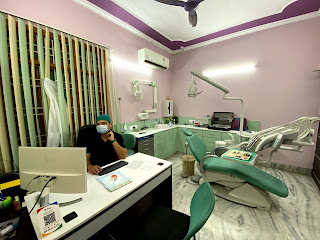Is It Normal to Have the Roots of Your Teeth Show?
A patient came in with severe gum recession where the root was exposed in front of one tooth. It didn't hurt; it just looked strange, and she wanted to know if it was a problem.
Usually, the teeth have adequate gum tissue to cover the roots, which should be embedded in bone. There is a small area between the bone and the gum tissue that is called the sulcus. It's in the sulcus that our bodies fight bacteria, called plaque, that collect on the teeth. In a healthy mouth, the sulcus measures between 1 and 3 millimetres. In a mouth that is fighting an infection caused by bacteria, the gum tissue recedes, and the sulcus deepens to 4 millimetres or more. If the gums are swollen, red or bleed easily, then the patient may have gingivitis, which is the first stage of gum disease. If untreated, the disease can worsen into periodontitis and can lead to bone loss. If the roots are exposed, then typically the tissue contours around the roots are poor, which can lead more bacteria to accumulate and more gum tissue to break down.
In a healthy mouth, the tooth roots are not exposed. If the roots are exposed, it’s usually a sign of one of these problems:
- Gingivitis or Periodontitis. Gum disease causes the gum tissue to pull away from the tooth, and the breakdown of the bone and tissue can expose the roots.
- Tooth developed outside of the jaw bone. In this case, one surface of the root has an area that is not covered by bone but only by soft tissue. This soft tissue can recede or break down and expose the roots of the tooth. Orthodontic treatment such as braces when not performed correctly can lead to moving the tooth outside of the bone and soft tissue, so make sure you ask your orthodontist about this.
- Brushing too hard. Aggressive tooth brushing can cause the gums to recede over time. Dentists recommend soft toothbrushes for this reason. Soft toothbrushes like power toothbrushes minimize the trauma to the tissue and bone.
If you have an exposed tooth root, it may be sensitive to temperature. Also, if the gum tissue is breaking down on the outside of the tooth, the side facing the cheek, then an infection could develop and cause the remaining bone to break down too. That causes the tooth to loosen and eventually fall out or need to be extracted.
If you have an exposed tooth root, you need to see a dentist. Your dentist will determine the quality and quantity of the gum tissue that remains. Usually, if you have more than two to three millimetres of recession, your dentist will recommend you see a Periodontist for a gingival graft.
However, if the gum recession is caught early, the tissue can be replaced, and your tooth may have an excellent prognosis. The tissue replacement procedure has minimal discomfort and usually takes about an hour to perform. The Periodontist will remove the tissue from one part of the mouth and transplant it to another region. There are minimal risks to this procedure, and complications are rare.In the patient who asked if it’s normal to see the roots of your teeth, she had gum recession, and a small fold of tissue inside her bottom lip called a frenum that was pulling on the tissue. We removed the frenum and repaired the gum tissue,
so the tooth roots were covered again. There were no reported complications, and the patient is doing very well!




Very well explained and well done with the case. A thumbs up from me👍🏻
ReplyDelete